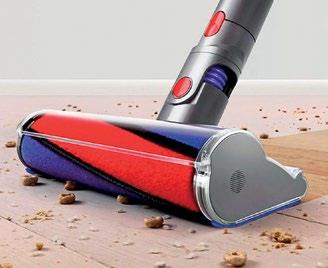Dyson Cyclone V10


Dyson Cyclone V10

Everything you need to know about the Dyson Cyclone V10 cordless vacuum is in its price. If you can fathom paying nearly a thousand dollars for a vacuum cleaner, then it’s likely you’ll have no regrets doing so. The V10 is a meticulously designed performance machine, built to vacuum, dust, and even filter. It performs like a champ, and I can’t find anything crummy to say about it.
The V10 succeeds the V8 cordless vacuum and is a different machine, both inside and outside. The V10 has a new V10 digital motor that is smaller but more powerful. It has a longer battery life, and different acoustics. The V10 also has a fresh design, which aligns the motor, bin, and cyclone in a straight line. This apparently creates 20% more suction power than the V8 and also makes it look like a ray gun.
One of the best things about the new chassis is that it’s now easier — and more hygienic — to empty the bin. On previous designs, you had to pull a release handle upwards to eject the bin. It got fiddly; my one-year-old V8 now insists on opening only if you pull up at angles it likes. On the V10, you point it downwards and push the ejection lever to release the bin. There aren’t any angles to fidget with, and you’re less likely to get caught in the dust bloom from the discharge.
Before you empty the bin, you have to use the V10, and it’s a pleasure to do so. The soft roller cleaner head glides and rotates smoothly. The accessories attach easily and give you a variety of cleaning options. The V10 has three power modes, compared to the V8. I’ve used the middle setting for around 20 minutes and still had two bars of battery life left (the V10 comes with a new battery indicator). I’ve also used the V10 at maximum and squeezed around 20 minutes out of it.
The V10 has a longer battery life of up to 60 minutes, while the V8 could run up to 40 minutes. How long you’ll actually get, however, depends on which attachment you use, the power mode you use, and how trigger-happy you are.
I try not to go maximum power except for short bursts. Ask the V10 to give maximum effort for too long and it gets toasty. The maximum power mode is also the loudest. The V10 is as quiet as a vacuum cleaner can get, but it seems the V10 pushes its sounds into higher frequencies. I don’t notice this, but my wife has hearing as sharp as a dog’s, and the V10’s whine annoys her. You might want to audition this for yourself if you, too, hear like a German Shepard.
I’m usually a grumpy reviewer, but I can’t find anything to fault the V10 for. That doesn’t mean there aren’t peculiarities. One of them is that you’ll have to clean the V10. The V10 sucks air and debris in from one end and expels it out the other. A filter sits there and Dyson says it traps 99.7% of particles as small as 0.3 microns. This filter needs to be washed once a month, and the V10 comes with a helpful indicator to remind you to do so. With only one filter, the V10 is easier to clean than the V8, which had two filters to wash.
The Dyson V10 takes everything good about the V8 and makes it better. Those advancements, like the longer battery life, powerful suction, and a user-friendlier bin, make the V10 easy to recommend. It sounds excessive to drop nearly a thousand dollars on a vacuum cleaner, but there are people who drop big money for other kinds of work tools, like chef’s knives and power drills. You’ll sweat while using these tools — but they provide a level of precision and joy you won’t find with lesser instruments.

The bin is easier to empty, simply point it down and push downwards on this red ejection lever.

You’ll have to clean the air filter once a month. Previously, you had to clean two filters on the V8.

CONCLUSION
Looks like a ray gun, isn’t cheap, and is very good.
PICTURES DYSON























